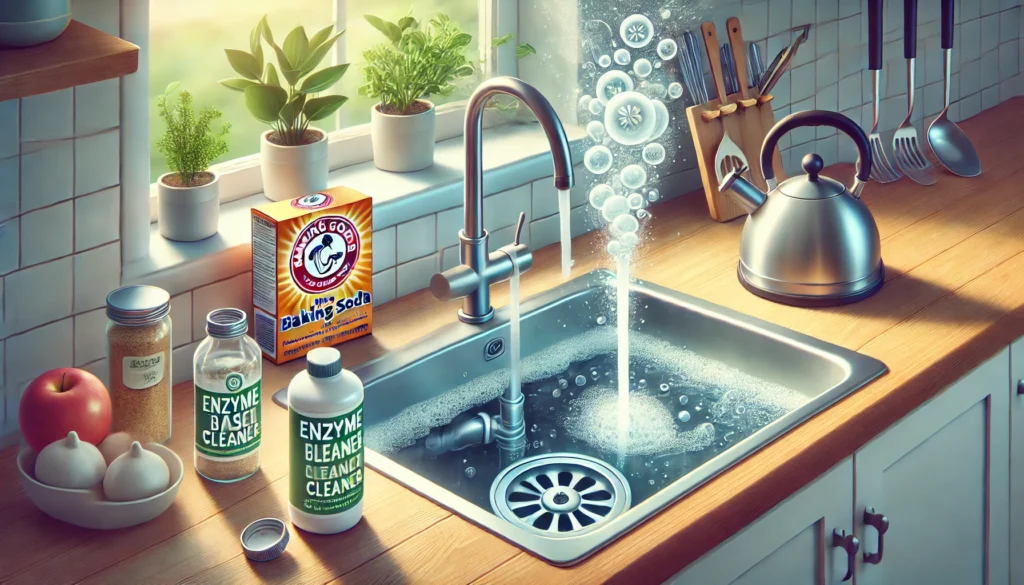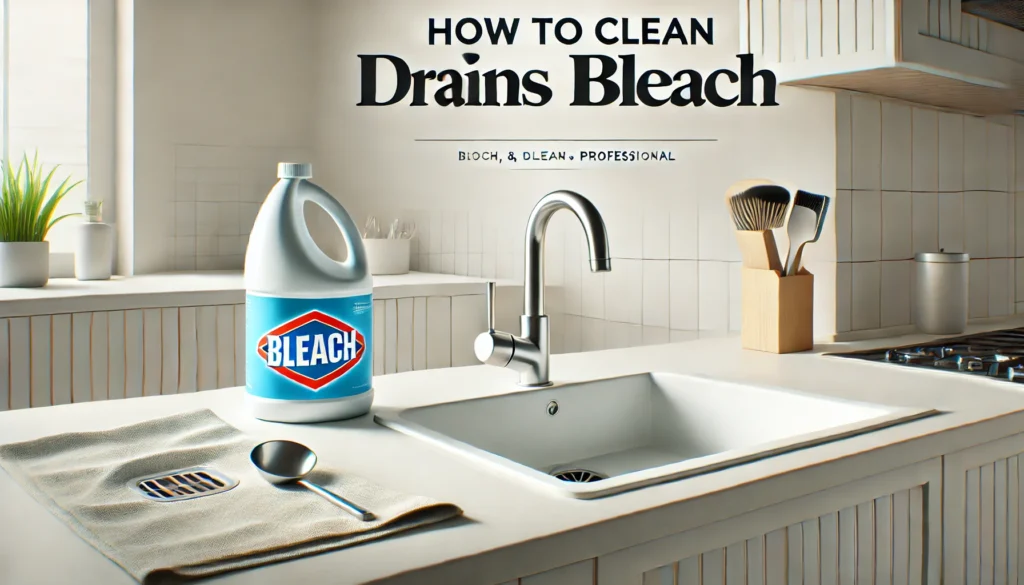Cleaning drains is an essential household task that ensures smooth water flow and prevents unpleasant odors. Over time, drains accumulate debris such as grease, hair, soap scum, and food particles, which can cause clogs and unsanitary conditions.
While there are several methods to clean drains, bleach is a simple and effective solution that not only removes debris but also kills bacteria, mold, and mildew. This article provides a detailed, step-by-step guide to clean drains with bleach, ensuring you can do so safely and effectively.
Table of Contents
Why Use Bleach for Cleaning Drains?
Bleach is a versatile and cost-effective cleaning agent that can be a powerful tool for maintaining clean and odor-free drains. Its potent disinfecting properties make it effective in eliminating harmful bacteria and mold that can thrive in damp, dark environments like drains.
By breaking down organic buildup, such as grease and grime, bleach can help prevent clogs and unpleasant odors. Its readily available nature makes it a convenient choice for many homeowners.
Precautions Before Clean Drains with Bleach
Before embarking on a drain-cleaning adventure with bleach, it’s crucial to prioritize safety. Bleach is a potent chemical that demands careful handling. Ensure you’re in a well-ventilated area with windows open or an exhaust fan running.
Don’t forget to equip yourself with protective gloves and safety goggles to shield your skin and eyes from potential irritation. Remember, bleach should never be mixed with ammonia or vinegar, as this can lead to the release of toxic fumes.
Additionally, avoid using bleach on galvanized steel pipes, as it can cause them to corrode. For completely clogged drains, a plunger or drain snake might be a more effective solution.

Tools and Materials Needed
Before you begin, gather the following materials:
- Household bleach (unscented is preferred)
- Rubber gloves
- Safety goggles
- Measuring cup
- Bucket or large container
- Old toothbrush or pipe brush (optional)
- Hot water
Step-by-Step Guide to Cleaning Drains with Bleach
Step 1: Preparing the Drain
Before diving into the chemical cleaning process, it’s crucial to manually clear the drain of any visible debris that might be causing blockages. This preliminary step will significantly enhance the cleaning effectiveness of the bleach.
Start by donning a pair of gloves and using tweezers to meticulously remove any large particles, such as hair or food waste, that may be obstructing the drain. This manual intervention will prevent these items from potentially mixing with the bleach and causing further contamination of the pipes.
Step 2: Diluting the Bleach
When using bleach for cleaning, it is vital to ensure it is diluted properly to prevent pipe damage and ensure a safer application. Start by filling a bucket or a sturdy container with warm water, then add a small amount of highly concentrated bleach while stirring gently to achieve effective dilution.
This method preserves the cleaning power of the solution while minimizing risks to the plumbing system. Always handle the mixture cautiously and apply it directly to the drain for optimal results.
Step 3: Cleaning the Drain
When cleaning the drain, begin by preparing a diluted bleach solution to avoid potential harm to skin and nearby surfaces. Carefully pour the bleach into the drain, ensuring minimal splash, and let it sit for 10 to 15 minutes to effectively disinfect, break down grease and grime, and eliminate odors.
After the waiting period, flush the drain with hot water, which not only rinses out bleach but also clears any loosened debris. This enhances water flow, leaving the drain free of blockages and lingering odors. If necessary, repeat the process after a few hours for optimal results.

When to Avoid Using Bleach
While bleach can be effective in cleaning drains, it’s essential to use it judiciously. Bleach can be harsh on sensitive materials like certain pipes and fixtures, potentially causing corrosion. Additionally, if you have a septic system, bleach can disrupt the natural bacterial balance necessary for proper waste breakdown.
In such cases, it’s advisable to opt for safer, more environmentally friendly cleaning methods. For stubborn clogged drains, consider using a plunger or a drain snake. If these methods prove ineffective, consulting a professional plumber is the best course of action.
Alternative Methods for Cleaning Drains
A simple mixture of baking soda and vinegar can effectively break down grime and odors in your drains. The fizzy reaction they create can loosen clogs. Follow up with hot water or boiling water to flush the debris.
For stubborn clogs, enzyme-based cleaners are an eco-friendly option. These cleaners use natural enzymes to break down organic material like hair and food particles, preventing future clogs.

Tips for Maintaining Clean Drains
Regular Maintenance is key to preventing major clogs. A simple way to avoid minor buildup is by using drain covers or screens to catch hair, food particles, and debris. Additionally, avoid pouring grease, coffee grounds, and fibrous foods like celery down the drain. For a deep clean, use a mixture of hot water and bleach.
While bleach is effective, be mindful of its corrosive nature. Always wear gloves and avoid mixing it with other cleaning agents. Regular maintenance not only keeps your drains odor-free and sanitary but also prevents wear and tear on your pipes, reducing the risk of costly repairs and leaks.
Check Similar Guide: How to Use Hydrochloric Acid to Unblock Drains: A Step-by-Step Guide!
Conclusion
Maintaining clean drains is essential for a hygienic and functional home, as it ensures the smooth operation of your household plumbing system. Using bleach effectively tackles clogs and eliminates unpleasant odors, making it a valuable tool in drain care.
Start by following these simple steps: carefully pour a diluted solution of bleach into the drain to minimize harm to the pipes while clearing debris. Employing caution is crucial to avoid potential damage to your plumbing and the environment.
For those seeking alternative methods, consider natural options like baking soda and vinegar. Regular maintenance and proper care of your drains ensure longevity, preventing recurring issues and supporting a smoothly functioning system.
Frequently asked Questions
How does bleach clean drains effectively?
Bleach cleans drains by killing bacteria, mold, and mildew that accumulate inside pipes. Its strong chemical properties break down grease, grime, and organic matter, leaving the drains disinfected and odor-free.
Can I pour bleach directly into the drain?
While bleach can be poured directly into a drain, it is safer and more effective to dilute it with water. Direct use of concentrated bleach may damage certain pipe materials and create strong fumes.
How often should I clean my drains with bleach?
Cleaning drains with bleach once a month is sufficient for regular maintenance. Overuse can lead to unnecessary exposure to chemicals and potential pipe damage.
Is bleach safe for all types of plumbing systems?
Bleach is generally safe for most modern plumbing systems, including PVC and copper pipes. However, it can corrode older pipes, such as galvanized steel, if used frequently or in high concentrations.
Does bleach help with unclogging drains?
Bleach is not designed to unclog drains but can loosen minor debris and residue. For severe clogs, mechanical tools like a plunger or drain snake are more effective.
Is it okay to use bleach in drains connected to a septic tank?
Bleach should be used sparingly in homes with septic systems. Frequent use can disrupt the bacterial balance necessary for breaking down waste, leading to potential septic system issues.
What precautions should I take when using bleach to clean drains?
Always wear gloves and safety goggles to protect your skin and eyes. Ensure proper ventilation by opening windows or using an exhaust fan. Avoid mixing bleach with other chemicals, as this can produce toxic fumes.
How long should I let bleach sit in the drain?
Allow the bleach to sit in the drain for 10 to 15 minutes. This duration is sufficient to kill bacteria, eliminate odors, and break down residue before flushing with hot water.
What should I do if the bleach smell persists after cleaning?
Run hot water through the drain to flush out any remaining bleach. If the smell lingers, pouring a mixture of baking soda and vinegar down the drain can neutralize the odor.
Can bleach damage the environment if used in drains?
Bleach can harm the environment if used excessively, as it may enter waterways and affect aquatic life. Always use bleach sparingly and consider eco-friendly alternatives when possible.
What alternatives can I use if I don’t want to clean drains with bleach?
Eco-friendly options include using a mixture of baking soda and vinegar, pouring boiling water down the drain, or opting for enzyme-based cleaners that break down organic material naturally.
Is it necessary to rinse the drain after using bleach?
Yes, rinsing the drain with hot water after using bleach is essential. This step ensures that any remaining bleach and loosened debris are flushed away, leaving the pipes clean and clear.
Can I use scented bleach for cleaning drains?
It is better to use unscented bleach for cleaning drains, as added fragrances can sometimes leave a residue or react with other substances in the pipes.
Should I clean bathroom and kitchen drains differently with bleach?
The process of cleaning is similar for both bathroom and kitchen drains. However, kitchen drains may require more attention to grease and food residue, while bathroom drains often need extra care for hair and soap scum buildup.
What are the signs that my drains need cleaning with bleach?
Signs include slow drainage, unpleasant odors, frequent clogs, or visible grime around the drain opening. Regular maintenance can help prevent these issues.








